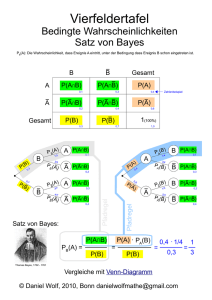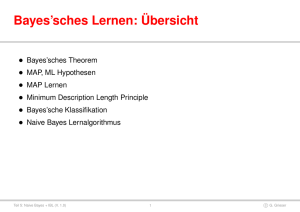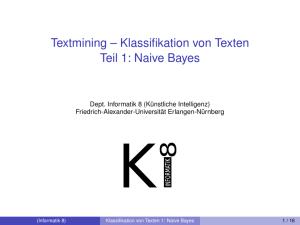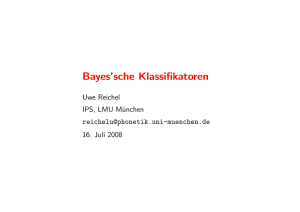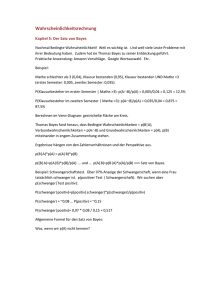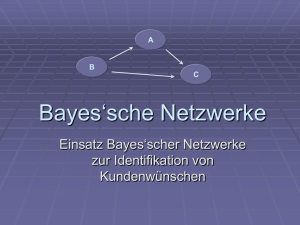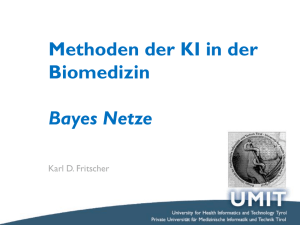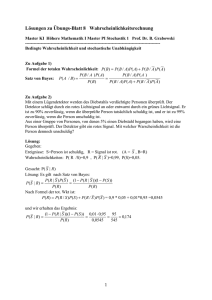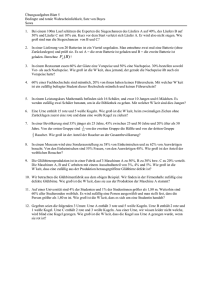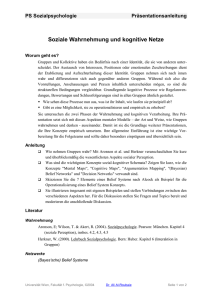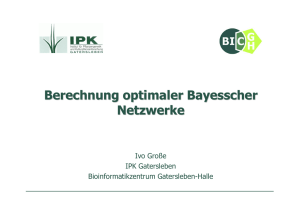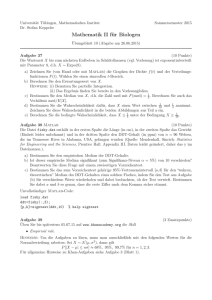bayes.pdf
Werbung
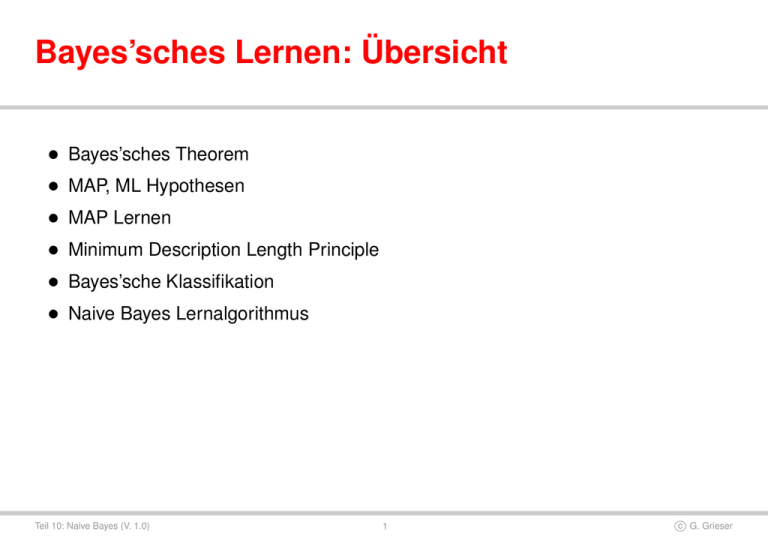
Bayes’sches Lernen: Übersicht • • • • • • Bayes’sches Theorem MAP, ML Hypothesen MAP Lernen Minimum Description Length Principle Bayes’sche Klassifikation Naive Bayes Lernalgorithmus Teil 10: Naive Bayes (V. 1.0) 1 c G. Grieser 2 Zielrichtungen der Bayes’schen Methoden Bereitstellen von praktischen Lernalgorithmen: • • • • Naive Bayes Bayes’sche Netze Kombiniere Wissen (a priori-Wahrscheinlichkeiten) und beobachtete Daten Erfordert a priori-Wahrscheinlichkeiten Bereitstellen eines konzeptuellen Modells • Standard“ zum Vergleich mit anderen Lernalgorithmen ” • Zusätzliche Einsichten in Occam’s Razor Teil 10: Naive Bayes (V. 1.0) 2 c G. Grieser Bayes’sches Theorem P (D|h)P (h) P (h|D) = P (D) • P (h) = a priori Wahrscheinlichkeit der Hypothese h • P (D) = a priori Wahrscheinlichkeit der Trainingsdaten D • P (h|D) = Wahrscheinlichkeit von h gegeben D • P (D|h) = Wahrscheinlichkeit von D gegeben h Teil 10: Naive Bayes (V. 1.0) 3 c G. Grieser Auswahl von Hypothesen P (D|h)P (h) P (h|D) = P (D) Suchen wahrscheinlichste Hypothese gegeben die Traingsdaten Maximum a posteriori Hypothese hMAP : hMAP P (D|h)P (h) = arg maxh∈H P (h|D) = arg max h∈H P (D) = arg max P (D|h)P (h) h∈H Unter der Annahme P (hi ) = P (hj ) kann man weiter vereinfachen und wählt die Maximum likelihood (ML)-Hypothese: hML = arg max P (D|hi ) hi ∈H Teil 10: Naive Bayes (V. 1.0) 4 c G. Grieser Bayes’sches Theorem Krebs oder nicht? Ein Patient erhält einen Labortest, das Ergebnis ist positiv. Der Patient weiß außerdem folgendes: Falls der Patient Krebs hat, ist der Test in 98% der Fälle korrekt. Falls der Patient keinen Krebs hat, ist der Test in 97% der F älle korrekt. Insgesamt haben .008 der gesamten Bevölkerung Krebs. P (krebs) = P (+|krebs) = P (+|¬krebs) = Teil 10: Naive Bayes (V. 1.0) P (¬krebs) = P (−|krebs) = P (−|¬krebs) = 5 c G. Grieser Grundlegende Formeln für Wahrscheinlichkeiten • Produktregel: Wahrscheinlichkeit P (A ∧ B) der Konjunktion zweier Ereignisse A und B : P (A ∧ B) = P (A|B)P (B) = P (B|A)P (A) • Summenregel: Wahrscheinlichkeit P (A ∧ B) der Disjunktion zweier Ereignisse A und B : P (A ∨ B) = P (A) + P (B) − P (A ∧ B) • Theorem der totalen Wahrscheinlichkeiten: Pn Wenn die Ereignisse A1 , . . . , An sich gegenseitig ausschließen und i=1 P (Ai ) = 1, dann P (B) = n X P (B|Ai )P (Ai ) i=1 Teil 10: Naive Bayes (V. 1.0) 6 c G. Grieser Brute Force MAP-Hypothesen-Lerner 1. Für jede Hypothese h in H , berechne a posteriori Wahrscheinlichkeit P (D|h)P (h) P (h|D) = P (D) 2. Gib Hypothese hMAP mit höchster a posteriori Wahrscheinlichkeit aus hMAP = argmax P (h|D) h∈H Teil 10: Naive Bayes (V. 1.0) 7 c G. Grieser Lernen einer reelwertigen Funktion Betrachte reelwertige Zielfunktion f Trainingsbeispiele sind hxi , di i, wobei die di verrauscht sind y f hML • di = f (xi ) + ei • ei ist Zufallsvariable (Noise) die e unabhängig voneinander für jedes xi bezüglich einer Normal- verteilung mit Mittelwert=0 gezogen werden x Die Maximum-Likelihood-Hypothese hML ist diejenige, die die Summe der Quadrate der Fehler minimiert: hML = arg min h∈H Teil 10: Naive Bayes (V. 1.0) n X i=1 8 (di − h(xi ))2 c G. Grieser ML-Hypothese beschreibt LSE-Hypothese? hML = argmax p(D|h) h∈H = argmax h∈H = argmax h∈H n Y i=1 n Y i=1 p(di |h) √ 1 2πσ 2 e − 21 ( di −h(xi ) 2 ) σ Maximiere stattdessen den natürlichen Logarithmus. . . Teil 10: Naive Bayes (V. 1.0) 9 c G. Grieser ML-Hypothese beschreibt LSE-Hypothese? hML n X 1 di − h(xi ) = argmax ln √ − 2 2 σ h∈H 2πσ i=1 2 n X 1 di − h(xi ) = argmax − 2 σ h∈H i=1 = argmax h∈H = argmin h∈H Teil 10: Naive Bayes (V. 1.0) n X i=1 n X i=1 1 2 − (di − h(xi ))2 (di − h(xi ))2 10 c G. Grieser Minimum Description Length Principle Occam’s Razor: wähle kleinste Hypothese MDL: bevorzuge Hypothese h, die folgendes minimiert: hMDL = argmin LC1 (h) + LC2 (D|h) h∈H wobei LC (x) die Beschreibungslänge von x unter Kodierung C ist Beispiel: H = Entscheidungsbäume, D = Labels der Traingsdaten • LC1 (h) ist # Bits zum Beschreiben des Baums h • LC2 (D|h) ist # Bits zum Beschreiben von D gegeben h – Anmerkung: LC2 (D|h) = 0 falls alle Beispiele korrekt von h klassifiziert werden. Es müssen nur die Ausnahmen kodiert werden. • hMDL wägt Baumgröße gegen Traingsfehler ab Teil 10: Naive Bayes (V. 1.0) 11 c G. Grieser Minimum Description Length Principle hMAP = arg max P (D|h)P (h) h∈H = arg max log2 P (D|h) + log2 P (h) h∈H (1) = arg min − log2 P (D|h) − log2 P (h) h∈H Interessanter Fakt aus der Kodierungstheorie: Die optimale (kürzeste) Kodierung für ein Ereignis mit Wahrscheinlichkeit p benötigt − log2 p Bits. Interpretiere (1): • − log2 P (h): Größe von h bei optimaler Kodierung • − log2 P (D|h): Größe von D gegeben h bei optimaler Kodierung → wähle Hypothese die folgendes minimiert: length(h) + length(misclassifications) Teil 10: Naive Bayes (V. 1.0) 12 c G. Grieser Klassifikation neuer Instanzen Bis jetzt haben wir die wahrscheinlichste Hypothese für gegebene Daten D gesucht (d.h., hMAP ) Gegeben neue Instanz x, was ist die wahrscheinlichste Klassifikation? • hMAP (x) ist es nicht unbedingt!!! Beispiel: • Betrachte 3 Hypothesen und gegebene Daten D: P (h1 |D) = .4, P (h2 |D) = .3, P (h3 |D) = .3 • Gegeben sei neue Instanz x, h1 (x) = +, h2 (x) = −, h3 (x) = − • Was ist hMAP (x)? • Whas ist wahrscheinlichste Klassifikation von x? Teil 10: Naive Bayes (V. 1.0) 13 c G. Grieser Bayes’sche optimale Klassifikation Bayes’sche optimale Klassifikation: arg max vj ∈V X hi ∈H P (vj |hi )P (hi |D) Beispiel: Deshalb: P hi ∈H P (h1 |D) = .4, P (−|h1 ) = 0, P (+|h1 ) = 1 P (h2 |D) = .3, P (−|h2 ) = 1, P (+|h2 ) = 0 P (h3 |D) = .3, P (−|h3 ) = 1, P (+|h3 ) = 0 P P (+|hi )P (hi |D) = .4 Teil 10: Naive Bayes (V. 1.0) 14 hi ∈H P (−|hi )P (hi |D) = .6 c G. Grieser Gibbs Klassifikation Bayes’sche Klassifikation optimal, aber teuer bei vielen Hypothesen Gibbs Algorithmus: 1. Wähle zufällig eine Hypothese h bezüglich P (h|D) 2. Benutze h zur Klassifikation Überraschung: Sei ein Zielkonzept zufällig bezüglich D aus H gewählt. Dann: E[errorGibbs ] ≤ 2 · E[errorBayesOptimal ] Teil 10: Naive Bayes (V. 1.0) 15 c G. Grieser Naive Bayes Klassifikation Neben Entscheidungsbäumen, Neuronalen Netzen, Nearest Neighbour eine der am meisten eingesetzten Lernmethoden. Wann anwendbar: • Mittlere oder große Traingsmengen • Attribute sind bedingt unabhängig gegeben die Klassifikation Erfolgreiche Anwendungsgebiete: • Diagnose • Klassifikation von Textdokumenten Teil 10: Naive Bayes (V. 1.0) 16 c G. Grieser Naive Bayes Klassifikation Ziel f : X → V , jede Instanz durch Attribute ha1 , a2 . . . an i beschrieben Wahrscheinlichster Wert von f (x): vMAP = argmax P (vj |a1 , a2 . . . an ) vj ∈V P (a1 , a2 . . . an |vj )P (vj ) = argmax P (a1 , a2 . . . an ) vj ∈V = argmax P (a1 , a2 . . . an |vj )P (vj ) vj ∈V Annahme von Naive Bayes: P (a1 , a2 . . . an |vj ) Naive Bayes Klassifikation: vNB Teil 10: Naive Bayes (V. 1.0) 17 = Q i P (ai |vj ) = argmax P (vj ) vj ∈V Y i P (ai |vj ) c G. Grieser Naive Bayes Algorithmus Naive Bayes Learn(examples) Für jeden Klassifikationswert vj P̂ (vj ) ← schätze P (vj ) Für jeden Attributwert ai jedes Attributs a P̂ (ai |vj ) ← schätze P (ai |vj ) Classify New Instance(x) vNB = argmax P̂ (vj ) vj ∈V Teil 10: Naive Bayes (V. 1.0) Y ai ∈x 18 P̂ (ai |vj ) c G. Grieser Naive Bayes: Beispiel Betrachte PlayTennis mit neuer Instanz hOutlk = sun, T emp = cool, Humid = high, W ind = strongi Wollen berechnen: vN B = argmax P (vj ) vj ∈V Y i P (ai |vj ) P (yes) P (sun|yes) P (cool|yes) P (high|yes) P (strong|yes) = .005 P (no) P (sun|no) P (cool|no) P (high|no) P (strong|no) = .021 → vNB = no Teil 10: Naive Bayes (V. 1.0) 19 c G. Grieser Naive Bayes: Diskussion 1. Annahme der bedingten Unabhängigkeit ist oft nicht erfüllt P (a1 , a2 . . . an |vj ) = Y i P (ai |vj ) • ...aber es funktioniert trotzdem erstaunlich gut. Warum? Abschätzungen für P̂ (vj |x) müssen nicht notwendig korrekt sein, sondern nur Y P̂ (ai |vj ) = argmax P (vj )P (a1 . . . , an |vj ) argmax P̂ (vj ) vj ∈V Teil 10: Naive Bayes (V. 1.0) vj ∈V i 20 c G. Grieser Naive Bayes: Diskussion 2. Was, wenn aufgrund kleiner Trainingsmengen keines der Trainingsbeispiele mit Klassifikation vj den Attributwert ai hat? Dann P̂ (ai |vj ) = 0, und... Y P̂ (vj ) P̂ (ai |vj ) = 0 i Typische Lösung ist sogenannte m-Abschätzung von P̂ (ai |vj ) wobei nc + mp P̂ (ai |vj ) ← n+m • n ist Anzahl der Trainingsbeispiele mit v = vj , • nc ist Anzahl der Beispiele mit v = vj und a = ai • p ist a priori Schätzung für P̂ (ai |vj ) (z.B. durch Annahme uniformer Verteilung 1 der Attributwerte → p = |values(a ) i )| • m ist Gewicht für a priori-Abschätzung p (Anzahl “virtueller” Beispiele) Teil 10: Naive Bayes (V. 1.0) 21 c G. Grieser
